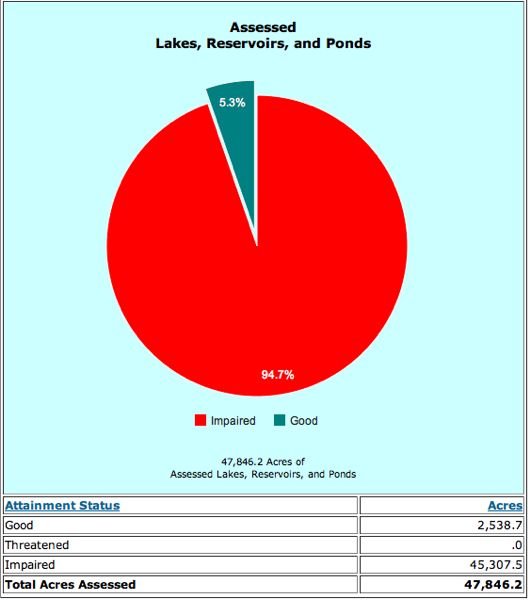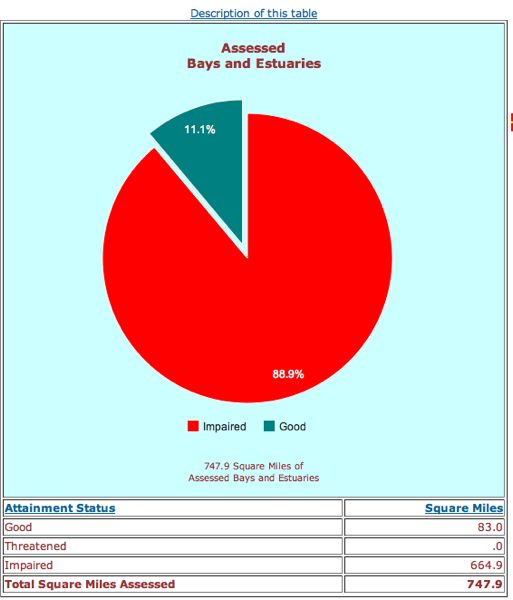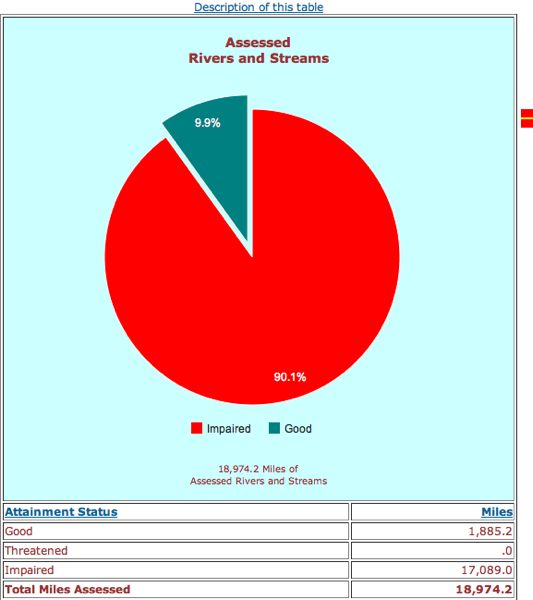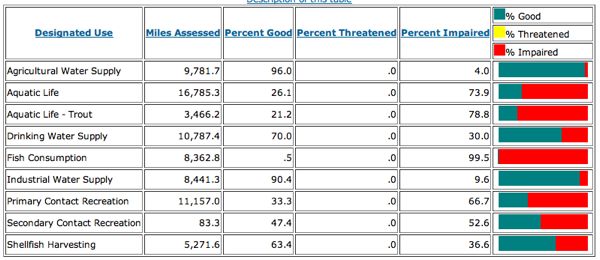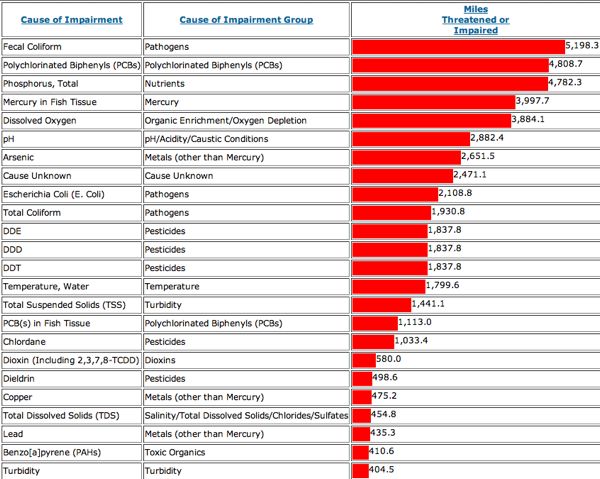Christie’s Legacy on Barnegat Bay? Press Releases, PR Stunts, and Junk Science to Flout Clean Water Act
DEP Conducts Press Stunts While Bay Suffers “Insidious Ecological Decline”
DEP Scientist Misrepresents Declining Ecological Health of the Bay
DEP held another “Barnegat Bay Blitz” litter cleanup on Friday – like Christie Town halls – with press in tow.
Remarkably, the Asbury Park Press quoted Commissioner Martin in this absurd headline:
Legacy? I’m reminded of Tim Weiner’s great book on the history of the CIA, “Legacy of Ashes”
As we’ve written numerous times (see this and this), Gov. Christie’s record on the Bay is awful:
- Christie vetoed a bill that would mandate pollutant reductions required to restore the health of the bay;
- Christie vetoed a bill that would have authorized counties to create and fund storm water management controls;
- Christie’s DEP rolled back protections that allow sewer service and dense development in thousands of acres of environmentally sensitive lands in the bay’s watershed, increasing pollutant loads instead of decreasing them and further reducing fresh water flows into the bay;
- Christie killed the Corzine DEP’s Clean Water Act permit to require cooling towers at Oyster Creek nuclear power plant;
- DEP got caught trying to delist the Bay from the Clean Water Act’s “impaired waters list” to avoid a legal cleanup obligation – a 7/27/12 Asbury Park Press editorial called the move “monumentality wrong headed, simply flabbergasting” (see: Despair over “impaired” list);
- Christie aggressively promoted and streamlined rebuild after Sandy, ignoring opportunities to improve land use and storm water management practices; and
- DEP Commissioner Martin issued an Order that deregulated reconstruction of public infrastructure and private development.
The bottom line is that while the ecological health of the Bay has continued to decline, Gov. Christie has blocked real reforms and actually taken steps to make conditions worse.
By any reckoning, that is a horrible record on Barnegat Bay – is that the kind of legacy “Birkenstock Bob” Martin is spinning?? (and BTW, Martin denied and lied about making that smear – either that, or Constable lied. But why would Constable lie about something like that?)
But aside from Commissioner Martin’s all too predictable spin, another DEP PR stunt, and the over the top legacy claim, perhaps the worst part of the whole thing was DEP scientist Tom Belton’s misrepresentation of the science on the health of the Bay:
Tom Belton, research scientist at the state DEP Office of Science and the research coordinator for the Barnegat Bay Research Initiative, said the bay is a suburban bay, so it is not a pristine ecosystem.
“The data that we’re collecting indicates it’s not in really heavy decline,” Belton said. “There’s a lot of really good fish here … the water quality is manageable. … A lot of people’s perceptions of the bay are based on observational — jelly fish, that’s all people want to talk about.”
It is hard to know where to start in responding to that line of bullshit.
I expect something like that from the Commissioner or the DEP Press Office, but it is shocking coming from a so called “DEP research scientist” (full disclosure: I have worked with Belton while at DEP).
Whether or not the bay is “suburban” or “pristine” – whatever those terms mean, they’re not science – is irrelevant to the ecological metrics and water quality standards that are supposed to be considered under the Clean Water Act to assess the ecological health of the Bay.
Similarly, I have no idea what “a lot” of “really good fish” mean, nor is the term “manageable” a valid term of law or science to describe water quality.
Worse, Belton crafts a red herring to dismiss those who have warned about the declining health of the bay, implying that those assessments are based on “perception” and narrowly focused on “jellyfish”.
Belton must know that exactly the opposite is the case – it is DEP that is fixated on seriously flawed water quality standards and assessment methods that ignore numerous indicators of ecological health and paint a false picture or the health of the bay.
All while DEP has failed to properly interpret and enforce the current narrative nutrient criteria with respect to eutrophication, water quality, and ecological health.
Rutgers professor Mike Kennish, perhaps the foremost expert on the Barnegat Bay ecosystem, testified to a Special Joint Senate and Assembly Hearing of the Legislature about all that back on August 13, 2012:
Kennish went into detail to explain why the DEP’s current water quality standards and assessment methods were flawed. First, because they rely exclusively on one indicator, dissolved oxygen (DO).
DO monitoring is flawed for at least 2 reasons:
1) because DEP only samples once per day in too few locations, which fails to capture large swings in DO levels throughout the day. This gives extremely misleading results, and DEP has known this for over 15 years;
2) because DO fails to reflect ecosystem health, particularly for critical indicators like submerged aquatic vegetation, fish and shellfish populations, and ecological relationships.
In response to a question by Chairman Senator Smith about whether the Bay was “impaired” under the Clean Water Act and should be required to undergo a TMDL, Kennish emphasized – with 100% scientific certainty – that the entire Bay currently is impaired and has been impaired since the 1980′s.
Kennish testified that: a) the Bay is experiencing an “insidious ecological decline”; b) that what DEP is doing is “clearly not working”; and c) that DEP water quality monitoring, standards and assessment have “no scientific validity” with respect to accurately portraying the ecological health of the Bay (hit this link for Kennish testimony, et al).
Kennish was critical of Gov. Christie’s 10 Point Management Plan and admonished DEP, concluding that they need to “seriously ramp things up”.
We wrote to EPA demanding federal intervention to force DEP to conduct a TMDL based on Kennish’s research and the DEP – EPA TMDL MOA, urging EPA to withhold federal Clean Water Act funding to NJ or conduct a TMDL themselves.
So, for Belton to imply that critics are driven by “perception” and over-reliance on jelly fish is flat out misleading and junk science.
Here are the ecological indicators Rutgers evaluated – and they are all in decline and far broader than jellyfish:
The ecosystem-based study (“Assessment of Nutrient Loading and Eutrophication in Barnegat Bay-Little Egg Harbor, New Jersey in Support of Nutrient Management Planning”) is the culmination of a multi-year, interdisciplinary research effort. The project characterized and quantified the estuary’s watershed nutrient loading, physical and water quality properties, biological indicators, and impacts.
“This study paints a rather bleak picture of the ecological health of the Barnegat Bay-Little Egg Harbor Estuary,” explains Mike Kennish. Barnegat Bay-Little Egg Harbor is highly eutrophic due to years of nitrogen and phosphorus enrichment. This estuary has experienced low dissolved oxygen concentrations, harmful algal blooms, heavy epiphytic loading, loss of habitat, diminishing hard clam abundance, and other detrimental effects. Since 2004, eelgrass condition has continually declined to a low point in 2010, and macroalgal blooms occurred frequently. The loss of seagrass beds is due in part to light reductions, and has a secondary impact on animal populations inhabiting them. Barnegat Bay-Little Egg Harbor is an estuary in ecological decline.
An index of eutrophication developed by Ben Fertig quantifies the overall condition of eutrophication in the estuary on a scale of 0 to 100, with 100 being the best. This index integrates 74,400 observations among 85 variables for 20 indicators in 6 components and is calculated based on comparisons to ecologically relevant thresholds and is weighted based on multivariate analyses. “Unfortunately, condition has gotten worse over time in much of the estuary,” notes Fertig. Eutrophication condition declined 34% and 36% in the central and south segments from 73 and 71 in the 1990s to 48 and 45 in 2010, respectively. Index scores for overall eutrophication condition are lowest in the north segment (37 during 2010), which has already undergone severe degradation, yet “the silver lining may be modest improvements in the north segment over time,” adds Fertig. Eutrophication Index values in the north segment rose from 14 in 1991 to 50 in 2009, but sharply dropped down to 37 in 2010.
It’s bad enough I have to call out this kind of bullshit from the DEP press office – but it is another kettle of fish and truly sad when the spin comes from the so called “research scientists”.


